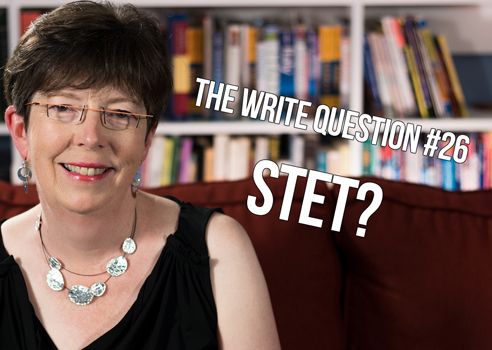Viewing time: 3 mins. 51 secs.
The Write Question is a weekly video podcast about writing that I started in 2017 and that ran, more or less weekly, until April 2022. This is a republication of issue #26, describing what the word stet actually means. The post first ran on July 28/17.
Transcript:
Welcome to The Write Question, I’m Daphne Gray-Grant. Today we’re talking about STET and other copy editing markings. Let’s see what makes the cut.
Today’s question comes from Fran Gerb in New York City. Here’s her call:
[recording] This is Fran, an avid reader of your column. I’m calling because I came across a word in a crossword puzzle that was new to me: STET. I looked it up and I know it is an editorial term. I could not find the word STET used in a sentence so I can’t get a full grasp of it without that. I was wondering if you use this term frequently in your editing. Thank you so much.
Thanks for the question, Fran. I love the arcane bits of knowledge I picked up during my 15-year career in the newspaper business. So I appreciate your giving me the opportunity to use that knowledge.
I’m not surprised you had a hard time figuring out the meaning of this term; it’s an unusual one. I learned the basics of copy editing when I was really young, working at my family’s weekly newspaper. The STET marking, used during copy editing and proofing, tells people to ignore or disregard previous markings on the page.
The etymology of the word is straightforward, though. It comes from the Latin, stet, meaning “let it stand.” Notice how the part where the “STET” applies also has little dots underneath it.
Do you see how the editor has written in red ink all over this paragraph? But they’ve had second thoughts and, after some reflection, they’ve decided that the author’s original text was okay. Because you can’t erase red ink, they’ve written STET, meaning that the typesetter, graphic artist and the author themselves should ignore all the ugly red markings and let the text stand, as it was originally.
Because STET is such a specific term, it’s hard to use in anything other than a rather workmanlike sentence. But since you asked:
“Write the word ‘stet’ on the proof to show that the alteration should be ignored.”
As I mentioned before, this term certainly sits in the arcane category of the English lexicon. And there are a few other obscure symbols like it used in copy editing.
I always enjoyed the swoop of the delete symbol but I found the line through a capital letter — to show it should be lower-case — to be a bit counterintuitive.
Most other copy editing marks are fairly self-explanatory, though. I’ve attached a link to those marks, below, so you can study them if you’re interested.
To answer your question about whether I use STET in editing, it depends on whether I’m editing on paper or editing electronically. If it’s the former, yes, I use it all the time. It’s easy for my pen to get ahead of my brain and, when that happens, the word STET saves me. But when I’m editing electronically, I don’t ever need to use it. The undo function is fantastically useful and a lot easier.
Finally, while we’re on the subject of copy editing, let me wrap up with a pithy comment from Mark Twain: “Substitute ‘damn’ every time you’re inclined to write ‘very’; your editor will delete it and the writing will be just as it should be.”
Thanks for your question, Fran. I hope this video is damn useful for you.


